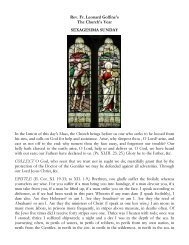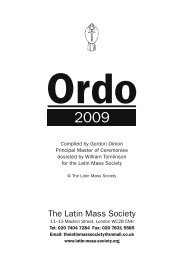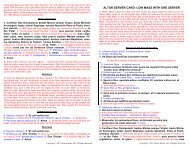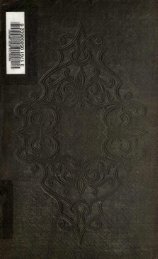The Spirit of Gregorian Chant - Church Music Association of America
The Spirit of Gregorian Chant - Church Music Association of America
The Spirit of Gregorian Chant - Church Music Association of America
You also want an ePaper? Increase the reach of your titles
YUMPU automatically turns print PDFs into web optimized ePapers that Google loves.
48 THE SPIRIT OF GREGORIAN CHANT<br />
Among the neums <strong>of</strong> the epoch which produced the more<br />
analytic type <strong>of</strong> graphic neum were still found many complicated<br />
signs ( vw/^sy^ etc.) in which one could see a fragment <strong>of</strong> the<br />
long sinuous line already spoken <strong>of</strong> in this chapter. 1 <strong>The</strong> rhetorical<br />
neum finds its origin in the graphic tracing <strong>of</strong> the movement <strong>of</strong> the<br />
hand corresponding to the tonic accent <strong>of</strong> the word, i.e., the rise<br />
<strong>of</strong> the speaker's voice—the ad cantum—followed by the natural<br />
drop <strong>of</strong> the voice with its corresponding hand movement. "Ac<br />
cents are gestures," says Quintilian. <strong>The</strong> fundamental and primitive<br />
signs <strong>of</strong> Latin rhetorical neum notation were, then, nothing<br />
other than the grammatical accents used from the time <strong>of</strong> Greco-<br />
Roman rhetoric to indicate the different inflections <strong>of</strong> the voice<br />
in discourse. <strong>The</strong> corresponding hand motion with the rise <strong>of</strong> the<br />
speaker's voice represented graphically from below to above produced<br />
a simple acute accent sign ( / ); for the drop <strong>of</strong> the voice<br />
with the corresponding descending movement <strong>of</strong> the hand, a reverse<br />
stroke, somewhat shorter ( \ ), was traced. 2 In musical notation<br />
the first sign was called a virga, the second a punctum.<br />
From the design <strong>of</strong> these two grammatical accents in multiple combinations<br />
<strong>of</strong> two and three, a veritable system <strong>of</strong> neum and rhythmic<br />
notation sprang up. Neums are voice undulations, and their notation<br />
is a practical system for conveying to the mind the multiplicity<br />
<strong>of</strong> modulations <strong>of</strong> the voice which sings.<br />
<strong>The</strong> Antijphonale Missarum Sancti Gregorii (X century), Codex<br />
339 <strong>of</strong> the Library <strong>of</strong> St. Gall, is probably the most ancient<br />
example <strong>of</strong> neum notation <strong>of</strong> combined accents. Its identity with<br />
manuscripts <strong>of</strong> Ambrosian <strong>Chant</strong> is not contested. 3 <strong>The</strong> manuscripts<br />
<strong>of</strong> the school <strong>of</strong> St. Gall, including those <strong>of</strong> Blessed Hartker<br />
and <strong>of</strong> Einsiedeln, are the most perfect and intelligible rhythmic documents.<br />
4 <strong>The</strong> manuscripts <strong>of</strong> Mets, Como, Laon and Milan are<br />
next, but in these a decline is already apparent, the copyists having<br />
largely abandoned the rhythmic signs. Despite this, the rhythmic<br />
concordance between the schools <strong>of</strong> St. Gall and Mets is astonishing,<br />
"peremptory pro<strong>of</strong> that one single rhythm determined down to its<br />
iRef., p. 40. *Cours., Ch. III. * Pal. mus., Vol. I. * Ibid, Vol. IX.
















